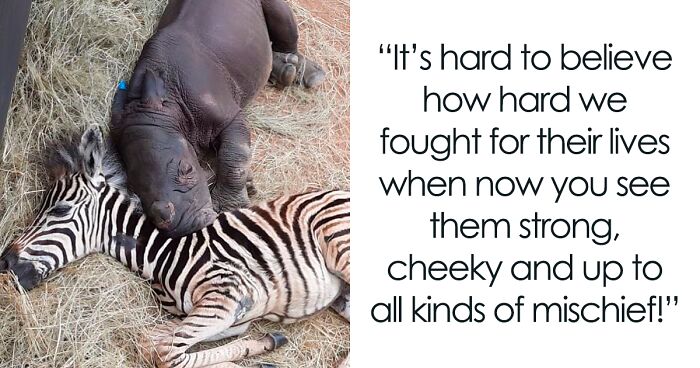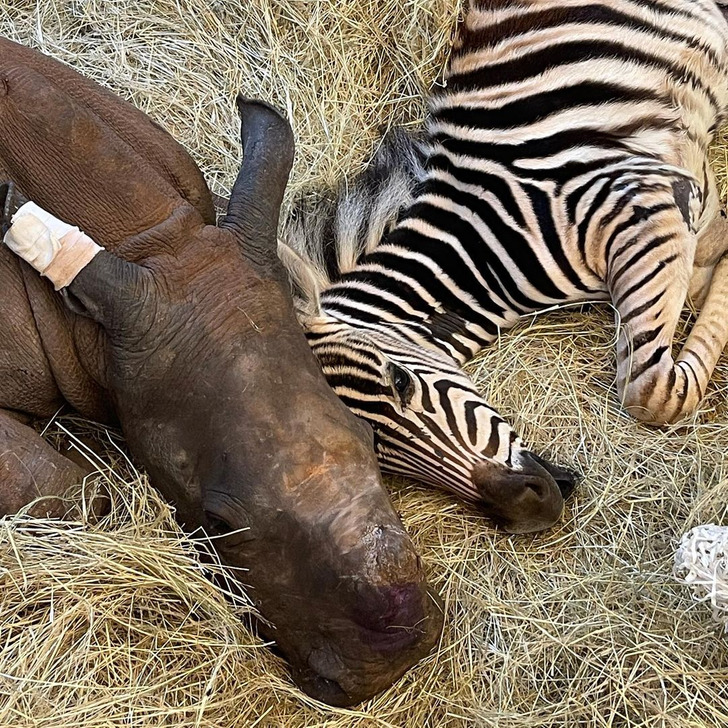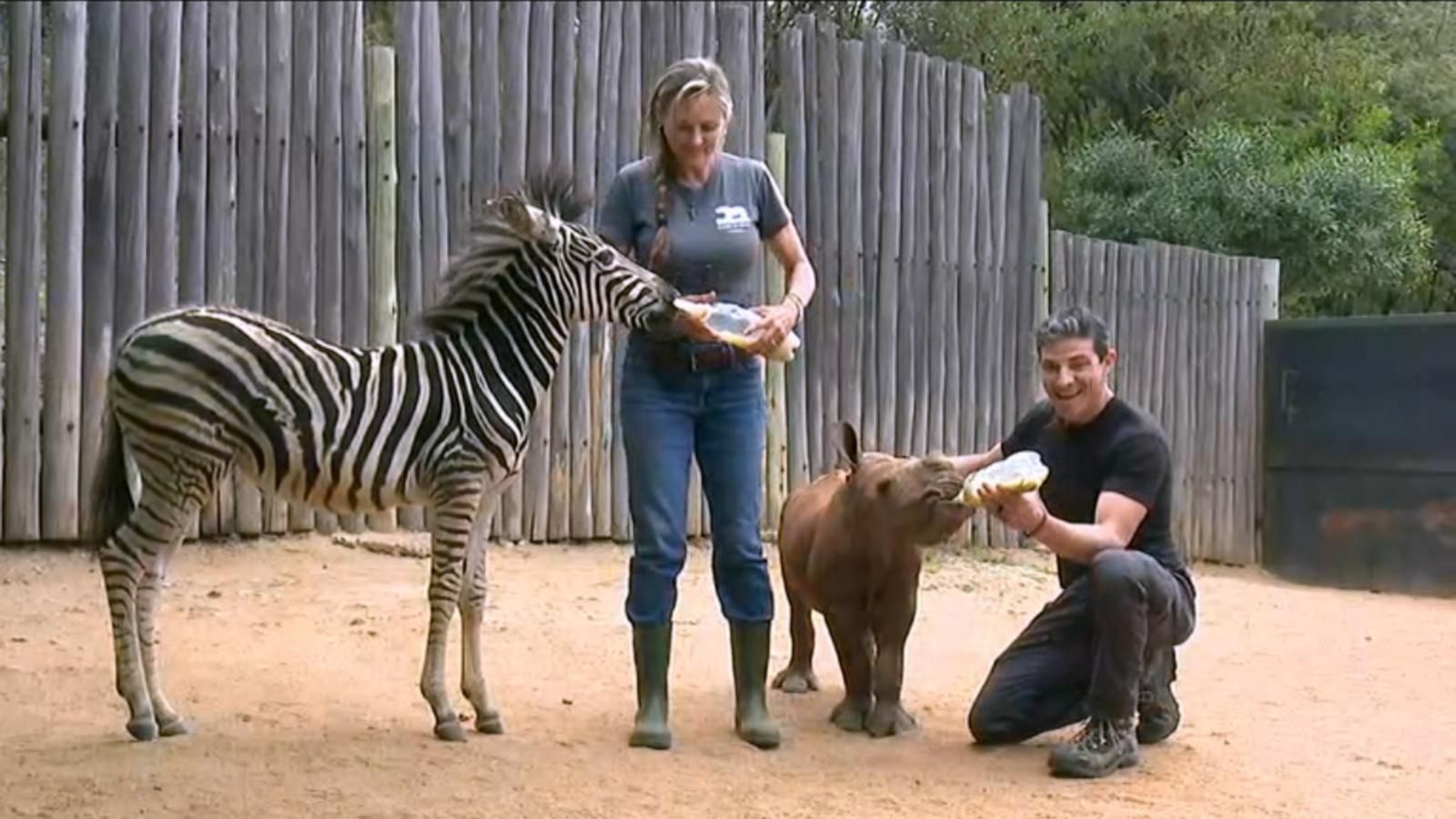A Fragile Beginning
When rescuers found Daisy, a newborn rhino calf, she was lying motionless beneath a withered acacia tree in South Africa’s Kruger region. Her breaths came shallow and slow, her skin pale beneath a coat of dust. Somewhere nearby, gunfire had echoed days earlier — a tragic reminder of the dangers that still threaten rhinos in the wild. Daisy was alone, abandoned, and barely clinging to life.
Her rescuers acted fast. Wrapped in blankets and loaded into a vehicle, she was taken to the Care for Wild Rhino Sanctuary, a facility specializing in the rehabilitation of orphaned wildlife. There, veterinarians fought through the night to stabilize her heartbeat and restore her strength. Tubes delivered milk and electrolytes; heaters kept her warm.
By dawn, Daisy had survived the first critical hours. But as the days passed, her caretakers noticed something troubling: while her body slowly healed, her spirit seemed adrift. She was lonely. For a creature born into close maternal care, isolation can be as dangerous as illness.

Enter Modjadji: The Little Striped Miracle
A week later, fate brought another orphan to the sanctuary — a zebra foal named Modjadji. The staff had found her after a violent thunderstorm swept across the plains, separating her from her herd. She was shivering, exhausted, and frightened.
When Modjadji arrived, the team placed her in a stall adjacent to Daisy’s recovery room. At first, they didn’t interact — one heavy and horned, the other striped and delicate. But something remarkable began to unfold.
Daisy perked up at the sound of soft hooves nearby. Modjadji, too, seemed curious about the quiet calf lying just beyond the wooden divider. Their gentle sniffs through the barrier soon turned into a silent language of comfort.
So, one morning, the caretakers opened the gate between them.
![]()
A Friendship Blossoms
What happened next melted everyone’s hearts. Instead of fear or hesitation, Daisy and Modjadji moved toward each other with surprising familiarity. The little rhino lowered her head as if to greet a friend; the zebra nuzzled her tenderly in response.
From that moment, they were inseparable.
Modjadji became Daisy’s shadow, walking alongside her during feeding times and lying close when the rhino needed rest. Daisy followed the zebra everywhere — to the water trough, the shaded enclosure, and even to the small patch of grass where the morning sun was warmest.
The two orphans seemed to have found in each other what they had lost: family.

Healing Together
Animals, like humans, respond to emotional bonds in powerful ways. Caretakers noticed Daisy’s appetite improving once Modjadji was near. Her energy levels rose, and her breathing stabilized. Even her playfulness returned — a sign her body was recovering.
Likewise, Modjadji gained confidence. Once timid, she now explored her surroundings boldly, often glancing back to ensure Daisy was following. Their synchronized movements, gentle nudges, and quiet companionship brought a rare kind of peace to the sanctuary’s recovery wing.
Scientifically, this makes sense. Studies in animal behavior show that social interaction and companionship can significantly accelerate recovery in mammals. The release of oxytocin — often called the “bonding hormone” — reduces stress and strengthens the immune system. What rescuers were witnessing wasn’t just cute; it was healing in motion.

Beyond Biology: The Cultural Meaning of Unlikely Bonds
Throughout history, humans have told stories of animals forming friendships across species — a lion befriending a lamb, a bird caring for a stray kitten, or a dolphin guiding a lost seal. These tales often carry symbolic weight: unity, compassion, and the breaking of boundaries.
In African folklore, animals are not merely wildlife; they are storytellers of human values. The rhino, strong yet gentle, represents resilience. The zebra, with its balanced black-and-white stripes, symbolizes harmony and coexistence.
In this sense, Daisy and Modjadji’s friendship becomes more than just a survival story — it becomes a living metaphor for hope. It reminds us that healing often begins where fear ends, and that comfort can be found in the most unexpected companionships.

Days Turn Into Months
As weeks turned into months, Daisy grew stronger. Her legs, once too weak to stand, now carried her through short walks in the sun. She began to graze and even engage in playful head bumps — a good sign that her instincts were returning.
Modjadji never strayed far. The zebra’s presence seemed to anchor Daisy emotionally, preventing the anxiety that often affects orphaned calves. At feeding times, caretakers could hardly separate them — if Daisy was bottle-fed, Modjadji stood nearby, waiting patiently until it was her turn for milk.
Caretakers often joked that they were “sisters from different stripes.”
As part of their rehabilitation, both animals gradually joined larger enclosures with others of their kind. The process was slow and carefully managed, ensuring they built confidence before re-entering the wild. Yet, even as they met new companions, their bond remained unbroken.
Science Behind Compassion
Modern wildlife rehabilitation increasingly acknowledges the importance of emotional and social enrichment. While traditional veterinary care focuses on the body, sanctuaries like Care for Wild have discovered that the mind and spirit play equally crucial roles in recovery.
Dr. Mary-Louise van der Merwe, one of the sanctuary’s veterinarians, once explained that orphaned animals often experience a form of trauma similar to human grief. “They don’t just lose their mothers,” she said, “they lose their sense of safety. Companionship gives that back to them.”
In the wild, young rhinos stay with their mothers for up to three years, learning how to forage, communicate, and recognize danger. Without that guidance, many fail to adapt. Modjadji’s friendship offered Daisy the emotional reassurance she needed to survive and grow.
It’s a rare case where empathy — something often thought of as purely human — becomes a bridge between species.

A Gentle Goodbye
Eventually, the time came for Daisy and Modjadji to prepare for reintroduction into protected reserves. Though they would not be released together — each species has its own habitat needs — caretakers observed that their time side by side had already shaped who they had become.
Daisy was strong, social, and confident — a survivor ready to join other rhinos. Modjadji, too, was thriving, displaying the calm assertiveness that zebras need to lead herds safely.
Their goodbye was quiet but meaningful. The staff noted how Daisy lingered near the gate when Modjadji was moved to another enclosure, and how the zebra turned back, as if to check that her friend was watching. There were no cries or struggles — just a shared stillness, like two souls understanding that what they had was forever.
A Symbol of What We Share
In a world often defined by division, Daisy and Modjadji’s story offers a soft-spoken lesson about empathy and survival. Their friendship didn’t just save two lives — it reminded everyone who witnessed it that love and trust transcend boundaries.
Whether viewed through the lens of biology, folklore, or simple wonder, their connection speaks to something deeply human: our longing to belong and to be understood.
The sanctuary team continues to share updates about both animals, inspiring people around the world. Their journey — from loneliness to companionship — has become a symbol of how healing multiplies when shared.

Reflection: The Heart of Human Curiosity
Stories like Daisy and Modjadji’s captivate us because they blur the line between instinct and emotion. They make us question how much of compassion is truly human — and how much is simply life recognizing itself in another form.
Perhaps that is why we are drawn to tales of unlikely friendships. They remind us of the simple truth that connection, in any shape or species, is what keeps the world alive.
Sources
-
Care for Wild Rhino Sanctuary
-
en.newsner.com
-
National Geographic: The Science of Animal Friendship
-
BBC Earth: When Wild Bonds Heal the Wounded
-
Smithsonian Magazine: Cross-Species Empathy in Nature
